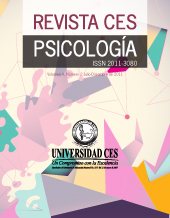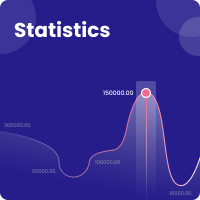Psychometric properties of a computerized emotional Stroop for assessing cognitive vulnerability
DOI:
https://doi.org/10.21615/cesp.10.2.7Keywords:
Attentional, Stroop, Anxiety, Emotion, Depression, Validity, ReliabilityAbstract
The purpose of this study was to design and validate a computerized Stroop test modified with emotional content and based on the bioinformational model, to facilitate pre-attentional and cognitive vulnerability researches. A quantitative empirical study with a non-experimental instrumental cross-sectional design was conducted. The sample consisted of 343 participants (58.6% females, 41.1% males), aged between 18 and 49 years old (M=24.36, SD=6.49), who were recorded on the response time to the stimuli. Results indicated a favorable internal consistency (α=.89), with a one-dimensional solution (Interference), that explained 63.75% of total variance. It was concluded the instrument is valid and reliable to assess emotional interference at pre-attentional level and it makes possible research on attentional processes and cognitive vulnerability.
Downloads
References
Albert, K., Gau, V., Taylor, W. D., & Newhouse, P. A. (2017). Attention bias in older women with remitted depression is associated with enhanced amygdala activity and functional connectivity. Journal of Affective Disorders, 210, 49-56. doi: 10.1016/j.jad.2016.12.010
Arias, B. (2008). Desarrollo de un ejemplo de análisis factorial confirmatorio con Lisrel, AMOS y SAS. Seminario de Actualización en Investigación sobre Discapacidad SAID 2008. Universidad de Valladolid: España. Disponible en http://www.benitoarias.com/articulos/afc.pdf
Askew, C., Hagel, A., & Morgan, J. (2015). Vicarious learning of children’s social-anxiety-related fear beliefs and emotional Stroop bias. Emotion, 15(4), 501-510. doi: 10.1037/emo0000083
Barlow, D. (2002). Anxiety and Its Disorders. Second edition. New York: The Guilford Press.
Başgöze, Z., Gönül, AS., Baskak, B., & Gökçay, D. (2015). Valence-based Word-Face Stroop task reveals differential emotional interference in patients with major depression. Psychiatry Research, 229(3), 960-967. doi: 10.1016/j.psychres.2015.05.099
Bausela, E. (2006). Utilidad del Stroop en la psicología clínica. Avances en Salud Mental Relacional / Advances in relational mental health, 5(1), 1-21.
Beck, A. T. (1967). Depression: Causes and treatment. Philadelphia: University of Pennsylvania Press.
Beck, A. T. (1983). Cognitive therapy of depression. En P. J. Clayton y J. E. Barret (comp.). Treatment of depression: Old controversies and new approaches (pp. 265-290). Nueva York: Raven Press.
Belloch, A. (2012). Propuestas para un enfoque transdiagnóstico de los trastornos mentales y del comportamiento: evidencia, utilidad y limitaciones. Revista de Psicopatología y Psicología Clínica, 17(3), 295-312.
Blatt, S. T. (1974). Levels of object representation in analytic and introjective depression. Psychoanalytic Study of the child, 29, 107-157.
Boehme, S., Ritter, V., Tefikow, S., Stangier, U., Strauss, B., Miltner, W. H. R., & Straube, T. (2015). Neural correlates of emotional interference in social anxiety disorder. PLoS ONE 10(6), e0128608. doi: 10.1371/journal.pone.0128608
Brereton, R. G. (2015). The Mahalanobis distance and its relationship to principal component scores. Journal of Chemometrics, 29(3), 143-145. doi:10.1002/cem.2692
Browne, M. W., & Cudeck, R. (1993). Alternative ways of assessing model fit. In K. A. Bollen & J. S. Long (Eds.), Testing structural equation models (pp. 136-162). Newbury Park, CA: Sage.
Byrne, B. M., Shavelson, R. J., & Muthen, B. (1989). Testing for the equivalence of factor covariance and mean structures: The issue of partial measurement invariance. Psychological Bulletin, 105(3), 456-466. doi:10.1037/0033-2909.105.3.456.
Cacioppo, S., Balogh, S., & Cacioppo, J. T. (2015). Implicit attention to negative social, in contrast to nonsocial, words in the Stroop task differs between individuals high and low in loneliness: Evidence from event-related brain microstates. Cortex, 70, 213-233. doi: 10.1016/j.cortex.2015.05.032
Caparos, S., & Blanchette, I. (2014). Emotional Stroop interference in trauma-exposed individuals: A contrast between two accounts. Consciousness and Cognition, 28(8), 104-112. doi: 10.1016/j.concog.2014.06.009
Carretero-Dios, H., & Pérez, C. (2007). Normas para el desarrollo y revisión de estudios instrumentales: consideraciones sobre la selección de tests en la investigación psicológica. International Journal of Clinical and Health Psychology, 7(3), 863-882.
Cea, M. A. (2004). Análisis multivariable. Teoría y práctica en la investigación social. Madrid, España: Síntesis.
Chung, Y., & Jeglic, E. L. (2016). Use of the modified emotional Stroop task to detect suicidality in college population. Suicide and Life-Threatening Behavior, 46(1), 55-66. doi:10.1111/sltb.12174
Clark, D. A., & Beck, A. T. (2010). Cognitive Therapy of Anxiety Disorders: Science and Practice. New York: The Guilford Press.
Clark, D. A., Beck, A. T., & Alford, B. A. (1999). Scientific Foundations of Cognitive Theory and Therapy of Depression. Nueva York: Wiley.
Colegio Colombiano de Psicólogos (COLPSIC). (2009). Deontología y bioética del ejercicio de la Psicología en Colombia. Bogotá, Colombia: Autor.
Consejo Nacional de Política Económica y Social (CONPES). (2005). Plan de acción para la focalización de los subsidios para servicios públicos domiciliarios. Documento aprobado el 10 de octubre de 2005. Bogotá: Autor. Consultado en julio17 de 2013. Disponible en http://www.dane.gov.co/files/dig/CONPES_3386_oct2005_Focaliz_subsidios_servicios_publicos.pdf
Dresler, T., Attar, C. H., Spitzer, C., Löwe, B., Deckert, J., Büchel, C. … Fallgatter, A. J. (2012). Neural correlates of the emotional Stroop task in panic disorder patients: An event-related fMRI study. Journal of Psychiatric Research, 46(12), 1627-1634. doi: 10.1016/j.jpsychires.2012.09.004
Dunkley, D. M., Blankstein, K. R., & Berg, J. L. (2012). Perfectionism dimensions and the five-factor model of personality. European Journal of Personality, 26(3), 233-244. doi:10.1002/per.829
Ellis, A. J., Beevers, C. G., & Wells, T. T. (2011). Attention allocation and incidental recognition of emotional information in dysphoria. Cognitive Therapy and Research, 40, 443-454. doi:10.1007/s10608-010-9305-3
Epp, A. M., Dobson, K. S., Dozois, D. J. A., & Frewen, P. A. (2012). A systematic meta-analysis of the Stroop task in depression. Clinical Psychology Review, 32(4), 316-328. doi: 10.1016/j.cpr.2012.02.005
Gantiva, C., Toro, R., Ballesteros, L., Salcedo, D., Vargas, R., Gutiérrez, Y., & Montes, K. (2012). Atención y motivación ante estímulos afectivos en personas con ansiedad social. Revista CES Psicología, 5(2), 79-87.
Kim, H. Y. (2013). Statistical notes for clinical researchers: assessing normal distribution using skewness and kurtosis. Restorative Dentistry & Endodontics, 38(1), 52-54. doi:10.5395/rde.2013.38.1.52
Hu, L. T., & Bentler, P. M. (1999). Cutoff criteria for fit indices in covariance structure analysis: Conventional criteria versus new alternatives. Structural Equation Modeling A Multidisciplinary Journal, 6(1), 1-55. doi:10.1080/10705519909540118
Iancovello, B. M., Grant, D. A., Alloy, L. B., & Abramson, L. Y. (2009). Cognitive Personality Characteristics Impact the Course of Depression: A Prospective Test of Sociotropy, Autonomy and Domain-Specific Life Events. Cognitive Therapy and Research, 33(2), 187-198. doi:10.1007/s10608-008-9197-7
Jiang, Z., Zhao, X., & Le, C. (2017). Self-control predicts attentional bias assessed by online shopping-related Stroop in high online shopping addiction tendency college students. Comprehensive Psychiatry, 75(5), 14-21. doi: 10.1016/j.comppsych.2017.02.007
Lang, P. J., Bradley, M. M., & Cuthbert, B. N. (1997). Motivated attention: affect, activation and action. En P. Lang, R.F. Simons y M.T. Balaban (eds.) Attention and orienting: Sensory and motivational processes, (pp. 97-135). Mahwah, N. J.: LEA.
Lang, P., Davis, M., & Öhman, A. (2000). Fear and anxiety: animal models and human cognitive psychophysiology. Journal of Affective Disorders, 61(3), 137-159. doi:10.1016/S0165-0327(00)00343-8
LeMoult, J., Kircanski K., Prasad, G., & Gotlib, I. H. (2017). Negative self-referential processing predicts the recurrence of major depressive episodes. Clinical Psychological Science: A Journal of the Association for Psychological Science, 5(1), 174 181. doi:10.1177/2167702616654898
Ministerio de Salud Nacional. (1993). Resolución 8430 de 1993. Por la cual se establecen las normas científicas, técnicas y administrativas para la investigación en salud. Bogotá, Colombia: Autor.
Montero, I., & León, O. G. (2007). A guide for naming research studies in Psychology. International Journal of Clinical and Health Psychology, 7(3), 847-862.
Morata-Ramírez, M. A., Holgado-Tello, F. P., Barbero-García, I., & Méndez, G. (2015). Análisis factorial confirmatorio. Recomendaciones sobre mínimos cuadrados no ponderados en función del error tipo I de Ji-cuadrado y RMSEA. Acción Psicológica, 12(1), 79-91. doi:10.5944/ap.12.1.14362
Newby, J., Pitura, V. A., Penney, A. M., Klein, R. G., Flett, G. L., & Hewitt, P. L. (2017). Neuroticism and perfectionism as predictors of social anxiety. Personality and Individual Differences, 106(1), 263-267. doi: 10.1016/j.paid.2016.10.057
Putman, P., Arias-García, E., Pantazi, I., & van Schie, C. (2012). Emotional Stroop interference for threatening words is related to reduced EEG delta–beta coupling and low attentional control. International Journal of Psychophysiology, 84(2), 194-200. doi: 10.1016/j.ijpsycho.2012.02.006
Öhman, A., & Mineka, S. (2001). Fear, phobias and preparedness: Toward an evolved module of fear and fear learning. Psychological Review, 108, 483-522. doi:10.1037//0033-295X.108.3.483
Sandín, B., Chorot, P., & Valiente, R. M. (2012). Transdiagnóstico: nueva frontera en psicología clínica. Revista de Psicopatología y Psicología Clínica, 17(3), 185-203.
Sánchez, A., & Vásquez, C. (2012). Sesgos de Atención Selectiva como Factor de Mantenimiento y Vulnerabilidad a la Depresión: Una Revisión Crítica. Terapia psicológica, 30(3), 103-117. doi:10.4067/S0718-48082012000300010.
Sato, T., & González, M. A. (2009). Interpersonal patterns in close relationships: The role of sociotropy–autonomy. British Journal of Psychology, 100, 327-345. doi:10.1348/000712608X331009
Siakaluk, P. D., Knol, N., & Pexman, P. M. (2014). Effects of Emotional Experience for Abstract Words in the Stroop Task. Cognitive Science, 38(8), 1698-1717. doi:10.1111/cogs.12137
Schrier, A. C., de Wit, M. A., Krol, A., Fassaert, T. J., Verhoeff, A. P., Kupka, R. W. … Beekman, A. T. (2013). Similar associations between personality dimensions and anxiety or depressive disorders in a population study of Turkish-Dutch, Moroccan-Dutch, and native Dutch subjects. The Journal of Nervous and Mental Disease, 201(5), 421-428. doi:10.1097/NMD.0b013e31828e110d.
Stroop, J. (1935). Studies of Interference in Serial Verbal Reactions. Journal of Experimental Psychology, 18(6), 643-662. doi:10.1037/h0054651
Toh, W. L., Castle, D. J., & Rossell, S. L. (2017). Attentional biases in body dysmorphic disorder (bdd): Eye-tracking using the emotional Stroop task. Comprehensive Psychiatry, 74(4), 151-161. doi: 10.1016/j.comppsych.2017.01.014
Vázquez, C., & Hernangómez, L. (2009). Automatic and controlled processing in depression. En R. Ingram (Ed.), International Encyclopedia of Depression (pp. 48-51). New York: Springer.
Watson, D., & Clark, L. A. (1984). Negative affectivity: The disposition to experience aversive emotional states. Psychological Bulletin, 96, 465-490. doi:10.1037/0033-2909.96.3.465
Witthöft, M. A., Mier, D. B., Ofer, J. B., Müller, T. B, Rist, F. C., Kirsch, P. B. … Diener, C. (2013). Neuronal and behavioral correlates of health anxiety: Results of an illness-related emotional Stroop task. Neuropsychobiology, 67(2), 93-102. doi:10.1159/000345545.
Downloads
Published
How to Cite
Issue
Section
License
Copyright (c) 2017 Ronald Alberto Toro Tobar, Bertha Lucía Avendaño Prieto, Hugo Alejandro Arias López, Julián Camilo Sarmiento-López

This work is licensed under a Creative Commons Attribution-NonCommercial-ShareAlike 4.0 International License.
Each manuscript is accompanied by a statement specifyingThat the materials are unpublished, that have not been previously published in printed formatElectronic and that they will not be presented to any other means before knowing the decision of the magazine. ThroughoutIn case, any previous publication, sea in printed or electronic form, must be made known to the editorial staffWriting The authors attach a signed statement stating that, and the manuscript is acceptedFor publication, the rights of reproduction are the exclusive property of the Journal CES Psychology.| Article metrics | |
|---|---|
| Abstract views | |
| Galley vies | |
| PDF Views | |
| HTML views | |
| Other views | |




